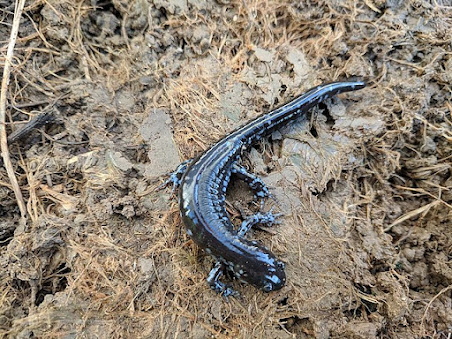 |
| Vernal pool by Assenmacher, CC BY-SA 4.0, Wikimedia |
It is now post-vernal equinox that signals astronomical spring but in New Jersey, it is more the meteorological spring that matters. Spring rains do create vernal pools (also known as intermittent or ephemeral ponds) which are temporary bodies of water filled by snowmelt, rain and rising groundwater for at least two consecutive months.
Though intermittent pools and ponds may form at other times of the year, these are usually full in the spring. Most vernal pools are natural, but they might be intentionally or accidentally (sometimes via construction) man-made. They will usually dry out by mid-summer, but their importance is as breeding places for amphibians. New Jersey has an estimated 3,000 to 5,000 vernal pools, on both public and private property.
One reason that they are preferred breeding places is that they lack predator fish that would feast on eggs and larvae. Vernal pools are not without predators and they are also important for wading birds, turtles, snakes and mammals, as well as rare plants and invertebrates like fairy shrimp and dragonflies. Turtles found in New Jersey’s vernal pools include wood turtles and spotted turtles.
Which amphibians might you find in a New Jersey vernal pool? Some threatened or endangered amphibians are included in the obligate species (meaning they are entirely reliant on vernal pools) including Eastern tiger, blue-spotted, marbled, Jefferson and spotted salamanders, along with wood frogs and Eastern spadefoot toads.
There are also many New Jersey amphibians who will breed in vernal pools but can also use more permanent bodies of water. This group includes the Southern gray treefrogs, Pine Barrens treefrogs, long-tailed salamanders, carpenter frogs, Fowler’s toads, Northern gray treefrogs, Northern spring peepers, bullfrogs, and four-toed salamanders.
We have written in other posts about the dangerous spring move by amphibians from their upland winter hibernation spots to vernal pools. The journey may be short but in NJ it often means crossing roads that separate upland forests from breeding pools. This migration occurs on rainy nights when the temperature is above 45 degrees Fahrenheit.
In our state, there are volunteers who each spring work at the busiest crossings to slow traffic. In other places, roads are even shut down entirely. (East Brunswick Township has closed Beekman Road on spotted salamander migration nights and the town’s Environmental Commission invites families to come out and see the crossings and the schools teach amphibian ecology.)
 |
| Blue-spotted salamander by GRMule, Public Domain, Link |
No comments:
Post a Comment